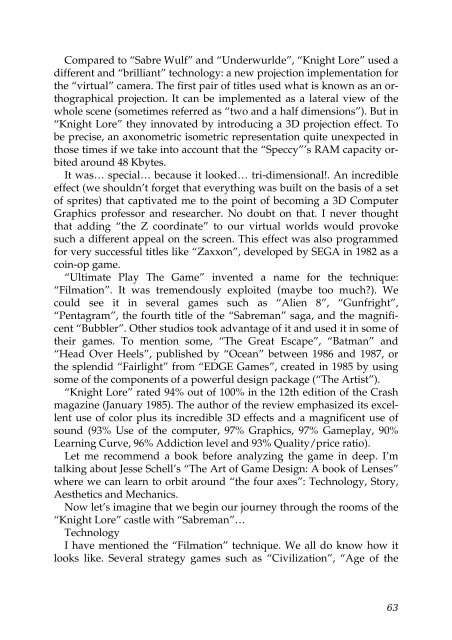Well Played 2.0: Video Games, Value and Meaning - OpenLibra
Well Played 2.0: Video Games, Value and Meaning - OpenLibra
Well Played 2.0: Video Games, Value and Meaning - OpenLibra
You also want an ePaper? Increase the reach of your titles
YUMPU automatically turns print PDFs into web optimized ePapers that Google loves.
Compared to “Sabre Wulf” <strong>and</strong> “Underwurlde”, “Knight Lore” used a<br />
different <strong>and</strong> “brilliant” technology: a new projection implementation for<br />
the “virtual” camera. The first pair of titles used what is known as an orthographical<br />
projection. It can be implemented as a lateral view of the<br />
whole scene (sometimes referred as “two <strong>and</strong> a half dimensions”). But in<br />
“Knight Lore” they innovated by introducing a 3D projection effect. To<br />
be precise, an axonometric isometric representation quite unexpected in<br />
those times if we take into account that the “Speccy”’s RAM capacity orbited<br />
around 48 Kbytes.<br />
It was… special… because it looked… tri-dimensional!. An incredible<br />
effect (we shouldn’t forget that everything was built on the basis of a set<br />
of sprites) that captivated me to the point of becoming a 3D Computer<br />
Graphics professor <strong>and</strong> researcher. No doubt on that. I never thought<br />
that adding “the Z coordinate” to our virtual worlds would provoke<br />
such a different appeal on the screen. This effect was also programmed<br />
for very successful titles like “Zaxxon”, developed by SEGA in 1982 as a<br />
coin-op game.<br />
“Ultimate Play The Game” invented a name for the technique:<br />
“Filmation”. It was tremendously exploited (maybe too much?). We<br />
could see it in several games such as “Alien 8”, “Gunfright”,<br />
“Pentagram”, the fourth title of the “Sabreman” saga, <strong>and</strong> the magnificent<br />
“Bubbler”. Other studios took advantage of it <strong>and</strong> used it in some of<br />
their games. To mention some, “The Great Escape”, “Batman” <strong>and</strong><br />
“Head Over Heels”, published by “Ocean” between 1986 <strong>and</strong> 1987, or<br />
the splendid “Fairlight” from “EDGE <strong>Games</strong>”, created in 1985 by using<br />
some of the components of a powerful design package (“The Artist”).<br />
“Knight Lore” rated 94% out of 100% in the 12th edition of the Crash<br />
magazine (January 1985). The author of the review emphasized its excellent<br />
use of color plus its incredible 3D effects <strong>and</strong> a magnificent use of<br />
sound (93% Use of the computer, 97% Graphics, 97% Gameplay, 90%<br />
Learning Curve, 96% Addiction level <strong>and</strong> 93% Quality/price ratio).<br />
Let me recommend a book before analyzing the game in deep. I’m<br />
talking about Jesse Schell’s “The Art of Game Design: A book of Lenses”<br />
where we can learn to orbit around “the four axes”: Technology, Story,<br />
Aesthetics <strong>and</strong> Mechanics.<br />
Now let’s imagine that we begin our journey through the rooms of the<br />
“Knight Lore” castle with “Sabreman”…<br />
Technology<br />
I have mentioned the “Filmation” technique. We all do know how it<br />
looks like. Several strategy games such as “Civilization”, “Age of the<br />
63

















